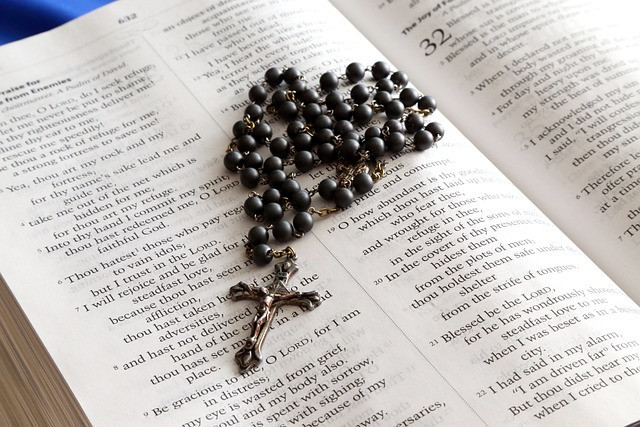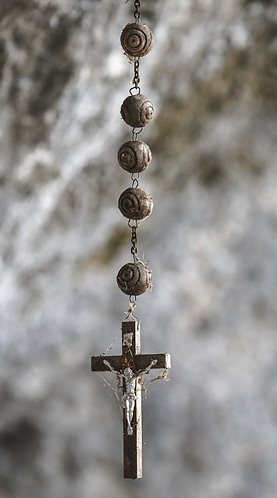
Hello Rosary lovers. In this post we will ask: why are there 59 beads on a Rosary?
It seems an odd number. What does 59 represent?
Nothing, as it happens (so far as I know).
However, 50 represents something, but to get there we need to explain a few things.
What the number 50 means
The Rosary is known as ‘the poor man’s Psalter’. The reason for this is historic.
The Book of Psalms is recited constantly by monastics. In the past (and perhaps still today in some places) monks would recite the entire Psalter daily.
How many Psalms are there? There are 150 Psalms.
But the laity didn’t have a copy of the Psalms because this was before the invention of the printing press. Most laity also could not read. And the laity didn’t know the Psalms off by heart.
The Psalms are called ‘the prayer book of the Church’. When people pray the Psalms, they are praying the Church’s prayer book.
So how could the laity pray? How could they participate in the Church’s recitation of the Psalms?
Well, there developed a wonderful method of praying which replaced a Psalm with an Our Father. Eventually, each Psalm was replaced with a Hail Mary (perhaps because the Hail Mary is shorter than the Our Father).
So since there are 150 Psalms, that would give us 150 Hail Marys.
How do you get to 50 from 150?
Many Catholics still pray 150 Hail Marys everyday, when they recite the traditional Rosary. Some even pray 200 Hail Marys daily! You can take a look at this post on 3 or 4 rosaries a day on this.
But 150 Hail Marys is still a lot for most Catholics. So eventually, the ENTIRE Rosary was split down to 3 separate rosaries. Each rosary contained 50 Hail Marys.
This was deemed by many to be a sufficient number of Hail Marys daily for most Catholics.
And this is where our sets of rosary beads come from. Rosary beads today contain only enough beads for 50 Hail Marys, rather than the traditional 150. You can however still buy rosaries that are over 150 beads in length.
The 50 beads on most rosaries are found in clumps of 10. These clumps of 10 beads are broken up by one individual bead which separates a set of 10 beads from another set of 10.
So this tells us where 50 of the 59 beads come from on the rosary beads.
9 extra beads – why?
But the Rosary contains 59 beads, not 50 beads. So what about the other 9 beads?
Well, 4 of these beads are designed for an optional introduction to the Rosary. This introduction to the Rosary prayers is one Our Father and 3 Hail Marys: 4 beads. These are the very first 4 beads on the Rosary, just after the crucifix. Notice this in the picture to the right.
 Though these introductory prayers to the actual Rosary prayers are optional, they are the most common prayers for introducing the Rosary. And that’s why we have the 4 beads after the crucifix.
Though these introductory prayers to the actual Rosary prayers are optional, they are the most common prayers for introducing the Rosary. And that’s why we have the 4 beads after the crucifix.
As for the remaining 5 beads scattered throughout the Rosary, these each represent an Our Father. 4 of them are found inbetween the clumps of 10 beads throughout the Rosary. 1 is found just after the 4 introductory beads, just before the ‘circle’ of the Rosary.
This is because at the beginning of each decade of Hail Marys, we pray an Our Father. So for the 50 Hail Marys, you pray 5 Our Fathers in total.
And that’s it! That’s why there are 59 beads on the most holy Rosary! 53 of these beads are for a Hail Mary, and 6 of them are for an Our Father.
I hope that clearly explained things. The number 59 is a weird number and on its own it doesn’t mean anything. But when we consider the history, it makes sense.
Different introductory prayers to the Rosary
Let’s just say a quick word on the introductory prayers to the Rosary. Many Catholics use a much shorter introduction to the Rosary, which involves much fewer words than 1 Our Father and 3 Hail Marys.
You can read about the different introductory prayers to the Rosary here.
But in short, the longer and more common version involves the sign of the cross, the recitation of the Apostles’ creed, one Our Father and 3 Hail Marys. This all takes about 2 minutes, about the time it takes to pray a decade of the Rosary.
The quicker introduction to the Rosary is common amongst Dominicans. It involves the sign of the cross, followed by half a Hail Mary: ‘Hail Mary, full of grace, the Lord is with thee. Blessed art thou among women and blessed is the fruit of thy womb Jesus.’
We then pray: ‘O Lord open my lips and my mouth shall proclaim your praise. O God come to my assistance; O Lord make haste to help me.’ (These words introduce monks and nuns to the Divine Office daily.)
You then finish with a Glory Be, followed by an Alleluia.
This introduction takes about 30 seconds. It’s a significant introduction which connects the Rosary to the Divine Office which is recited daily by monastics. We see here that the Rosary is indeed the laity’s replacement for the daily recitation of the Psalms.
Personally I much prefer the shorter introduction to the Rosary because then I can get right into reciting the actual Rosary.
If you have any questions, or comments, please get in touch!
Rosary Lovers constantly promotes the glory of Mary and her Rosary. As such, we often direct readers to this gorgeous collection of long-lasting paracord rosaries.
God bless you, through Mary Queen of heaven and earth! 🙂
An interesting and enlightening article! I’d always puzzled why there are 59 beads on a rosary, and this article clarified this tradition’s historical and symbolic meaning. It was very fascinating to learn about the relationship between the beads and the prayers in the rosary.
I’m wondering whether there are any differences or exceptions to this custom in different cultures or religious sects that employ the rosary. Do you have any ideas about how the number of beads on a rosary varies between traditions or regions?
Hi there! I’m glad it proved useful.
There are other religious and Christian traditions that use rosaries or prayer beads. The numbers of beads often differ from tradition to tradition, as you can see in this post:
https://rosarylovers.com/do-ch…
Other than this, I can’t be of much use.
Thank you!
As a Catholic, I find this topic very interesting and it’s always great to learn more about the history and traditions of the faith. I just love the way you have broken down the meaning behind the number 59 and how it relates to the different prayers and devotions of the rosary. It’s fascinating to see how something as seemingly simple as the number of beads on a rosary can hold so much symbolism and meaning. This is a testament to the rich and deep history of the Catholic faith, and the importance of tradition and ritual in connecting with the divine.
Many thanks for your thoughts here! I’m encouraged by your response 🙂
God bless